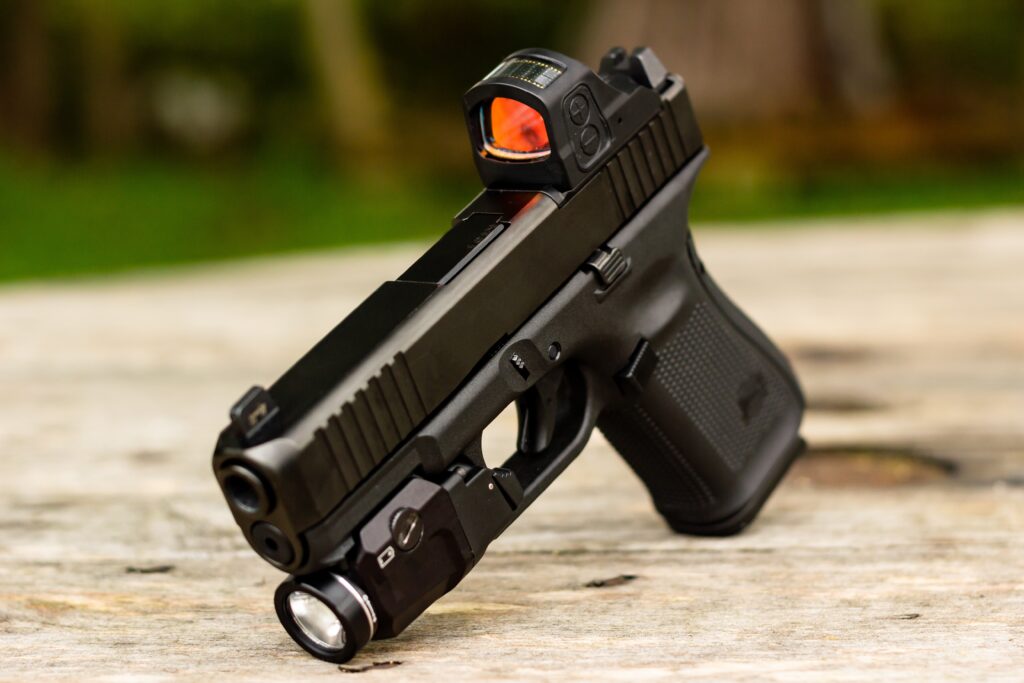By Det/Sgt Jeff Johnsgaard
This article is intended to speak to two training implementations for pistol mounted Red Dot Sights (RDS) that we believe are in line with evidence-based principles.
Law Enforcement is a profession which seems to be driven more by technology and not by Human Factors and Research. From conducted energy weapons to ‘quick’ handcuff pouches, from enhanced triggers to expensive simulators and virtual reality, we see a lot of technology driving the perception of improving officer performance.
We are involved heavily in the areas of Research and Human Factors. Simply put, what are people actually capable of doing in the environment where officers are encountering deadly force and what empirical evidence supports this? This is the foundation of what we must understand to train our officers to perform as optimally as possible.
Law Enforcement Officers Killed Assaulted (LEOKA) statistics show (https://leoka.org);
Officers are being killed and injured primarily by handguns, being hit in the head, neck & upper chest, in rapidly evolving, close-up encounters.
- Over 70% of officers killed were at a distance of 0-10 feet (2019)
- Handguns were the firearm type of choice to kill officers 77% of the time (2019)
- Officers killed were hit in the head and neck 64% of the time and head, neck and upper chest 86% of the time (2009-2019)
- Of officers killed 6/10 did not get their own weapon out or able to fire it (2018; speaks to the rapid nature of the attack, typically at very close distances)
Force Science® (www.forcescience.com) has studied the speed of assault for a firearms, edged weapons and physical assaults. The speed an average person can draw and fire a hidden handgun toward an officer during a traffic stop or other encounter is about a quarter to three quarters of a second.
2005 research (see citations) concluded it takes a minimum of half a second for a 60% chance you will realize there is an object at all, and this is not knowing what that object actually is. To have a chance at detecting, identifying and categorizing an object must be stable on the central part of our vision (fovea) which it will not be if the suspect is rapidly producing it, like suddenly driving a pistol toward you from a pocket or out of view at a traffic stop.
Meaning the first clue to most officers they are being assaulted by a handgun in close proximity, are the rounds incoming to them.
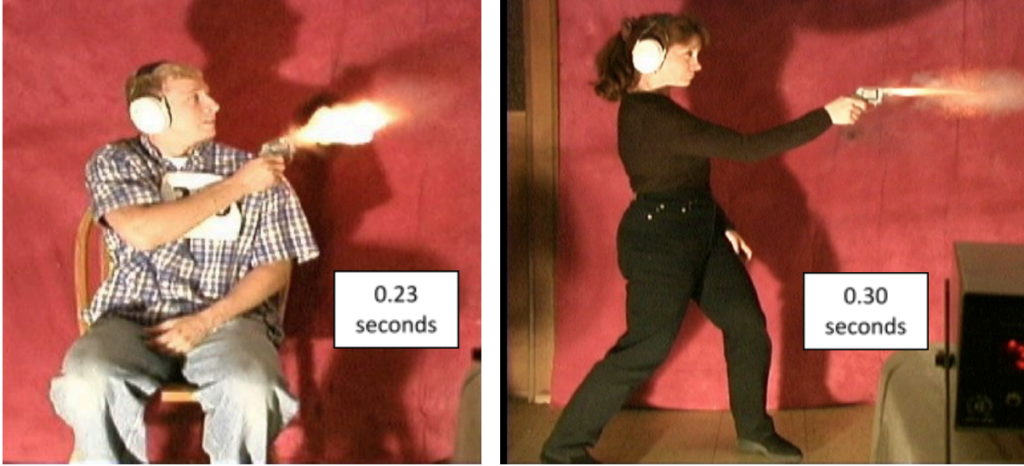
Two pictures from a Force Science® assault time testing, seated and standing (shown with permission)
How can an RDSs help officers in these rapid, close assaults?
Pistol Mounted Red Dot Sights
Currently there are many well intentioned Firearm Instructors looking to bring pistol mounted Red Dot Sights (RDS) to their officers. They are doing it because they believe the technology will bring advantage to their officers and in turn increase their officer’s ability to perform, protect the public and hopefully make better decisions in deadly force encounters.
We have asked many agencies around the world who have adopted or want to adopt pistol RDSs why they believe it is a good thing? These include all levels of US Law Enforcement, and law enforcement in Australia, Europe and Canada. The most common answer was the Firearms Instructors believed it will, “save time in a gunfight”.
They explained this was done by allowing the officer to keep their visual focus on the threat and not spend time shifting visual focus (called accommodation) between their front sight and the threat.
The thinking is that officers would save the time typically spent shifting back and forth between the intended target and their sights to make an accurate shot. Thus, officers could fire their pistols sooner and hopefully more accurately.
The concept of visual focus time is sound logic as it does take time to visually accommodate. That time is measured in fractions of a second, one study by Lewinski et. al. put it at 0.18ms (2015). Though very brief it certainly counts as a benefit we want officers to leverage, especially when LEOKA stats show most officers are killed by a firearm in an incident that unfolded in just a few seconds and typically at very close range.
Possible Issue
A RDS will only aid an officer if they would be using their iron sights when firing.
Are officers who perform optimally in these rapidly evolving, close-up assaults using their sights?
To address this, we will briefly examine a study done by Force Science® titled, “Performing under pressure: Gaze control, decision making and shooting performance of elite and rookie police officers” (2012). Here Elite counter terrorism members and Rookie patrol members were put into a rapidly evolving scenario where a subject suddenly reached into his waistband and spun toward the officers with either a cell phone or a pistol.
All officers had their vision monitored with eye tracking glasses. This was recorded and we can see exactly where their central (foveal) vision was placed throughout the entire scenario.
The result was the Elite shot more accurately (74.6% hits) than the Rookie officers (53.8% hits) and shot in error 18.50% vs the Rookie officers who shot in error 61.50% of the time.
These findings are important but there is more to the story. Does the eye tracking give us any ideas how the Elite accomplished weapon ID and accuracy so far above the Rookies?
The Elite placed their vision to the location the cell phone/weapon was likely to be produced toward. They did this while concurrently getting their pistol out and presenting it.
What did the Rookies do? The Rookies looked away from the rapidly turning subject, driving their eyes toward the floor and their gun front sight as they drew and brought up their pistols.
See the following three photos (shown with permission) from the study and look at the small red circle, that is the officer’s central vision. In the first photo the Elite officer sees a “critical cue”, a 90-degree bend in the subject’s elbow which has him “see into the future” that the subject is likely to spin.
In the 40-hour advanced instructor course created by Insp. Chris Butler (Ret.) Methods of Instruction (www.raptorprotection.com), we term this ability to recognize and predict what, where, when and how a threat is likely to evolve as “Game IQ”.
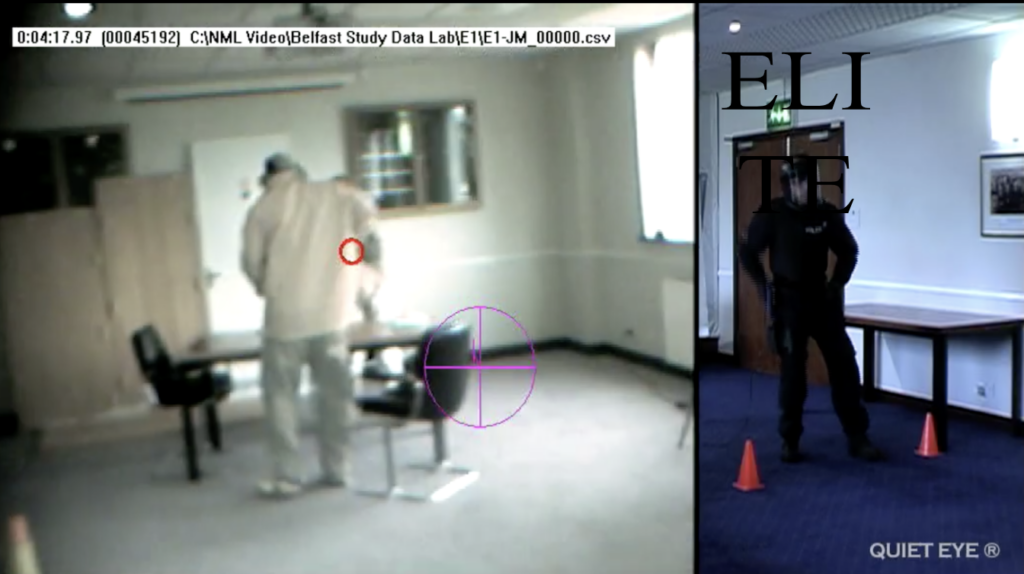
The second photo shows the Elite officer move their vision to where the subject’s hands will be while simultaneously drawing and presenting their own pistol.
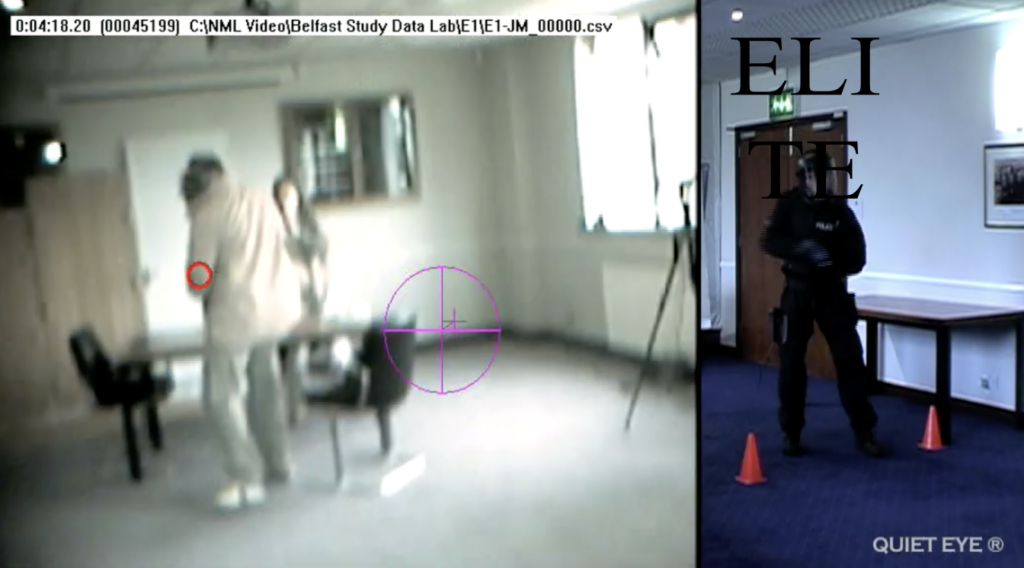
The third photo shows the Elite officer correctly identify a weapon and fires (more on firing in a moment).
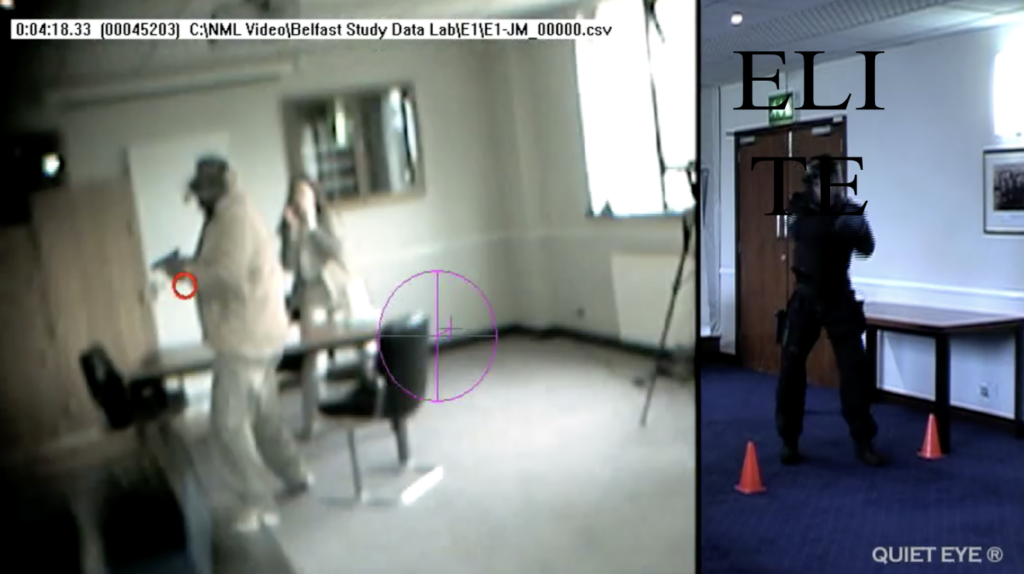
Compare that to the Rookie officer in the next three photos. Rookie photo one shows us he is not actually looking at the critical cue of the subject’s elbow as the Elite officer was. This tells us the Rookie does not know the locations where critical information is likely to come from. The Rookies do not have Game IQ.
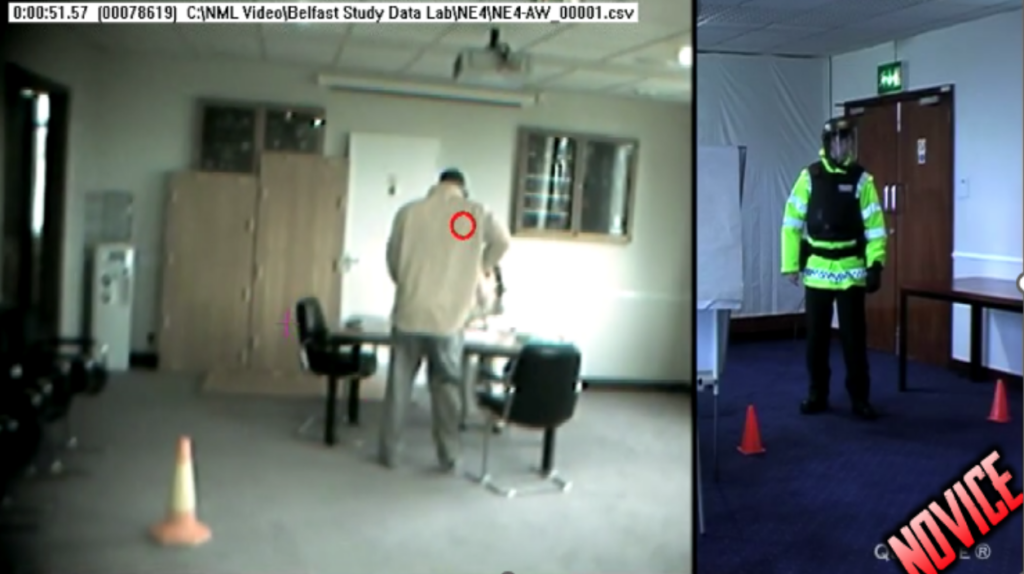
In photo two the Rookie perceives the subject rapidly spinning and that there is possible danger. The Rookie starts to get their pistol out and their vision starts driving to the floor. We speculate this is because “we” trained him to do that. We ‘wired in’ the response to look for a ‘clear front sight’ when shooting. We did not offer actual moving and evolving people as possible threats, only paper targets and preached accuracy over speed and threat identification.
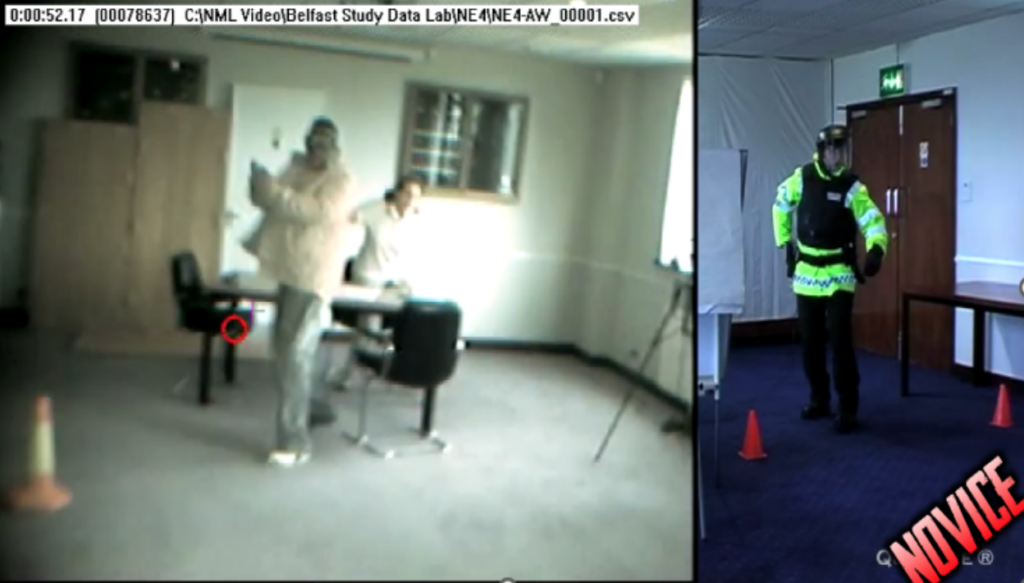
The main problem in photo two is that the Rookie still has not identified if the subject has a weapon or not. They will also not be able to do so in time if they are looking for their own pistol. Also, the Rookie is much later in their response to the subject than the Elite was.
These are massive training scars most Firearms Instructors would never identify.
Photo three reinforces both the lateness of the Rookie’s movement, subject spun fully and firing while the Rookie still has not gotten his pistol out of the holster.
Add to this the lack of Game IQ to predict a threat was likely evolving, means the Rookie moved late and is far behind in their response. Photo two shows the Rookie does not even have their pistol out of the holster yet.
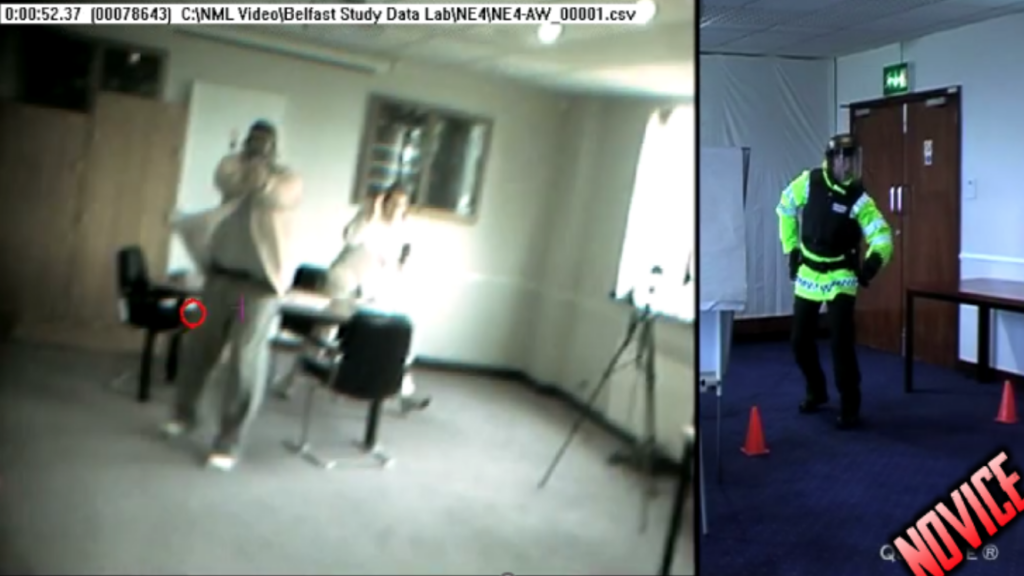
Another important finding from the study is,
The Elites did not move faster than the Rookies, they moved sooner.
Elites moved sooner because they knew the critical information areas and cues to initiate their movement.
A last key point to this study that will help inform us to training of RDSs comes from answering the following question.
Where did the Elite look when firing their weapons?
Where were the Elites and Rookies visually focused when they were firing at the subject? We already know where the Elites were looking to identify weapon/cell phone, where did they look when firing? The following photo is of the same Elite officer who shifted their visual focus to the chest of the subject right after identifying the weapon.
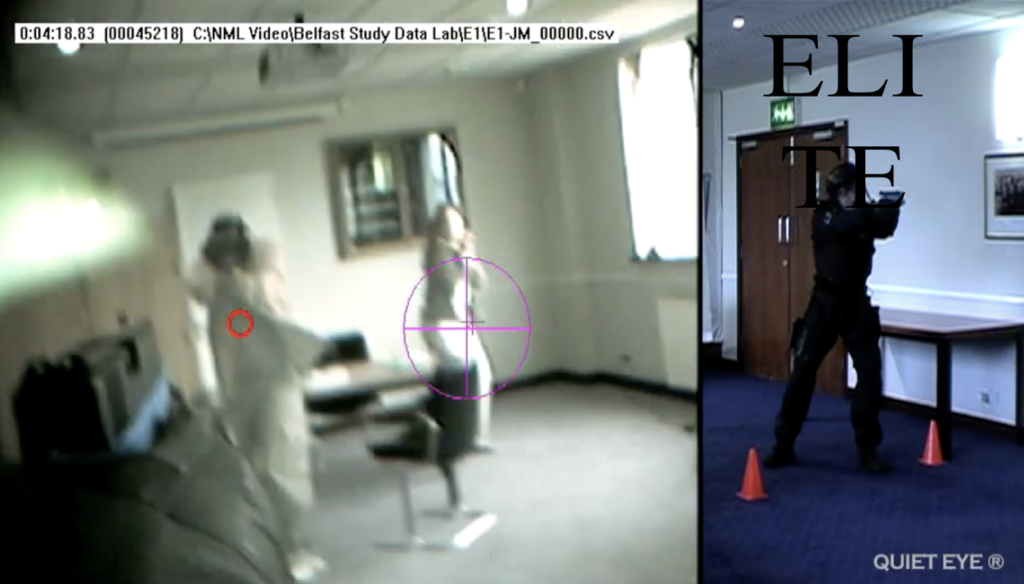
The Elite performed Gaze-Action Coupling and did an important shift of vision from the suspect’s weapon to where he wanted the bullets to go. You can see from the following picture the Elite was not looking at their sights.
Key Takeaway: Elites moved sooner, made accurate ID of the weapon then shot accurately to center mass of the subject (firing before the subject did).
Where did the Rookie look when firing?
The following two photos show the Rookie moving to find their front sight and not ID weapon/cell phone. They then shift their vision back to the attacker and are so far behind the action reaction curve they end up firing before they gain sight alignment & sight picture (or Gaze-Action Coupling). The Rookie was very late in their response, firing after the subject did and was also inaccurate, missing the subject completely.
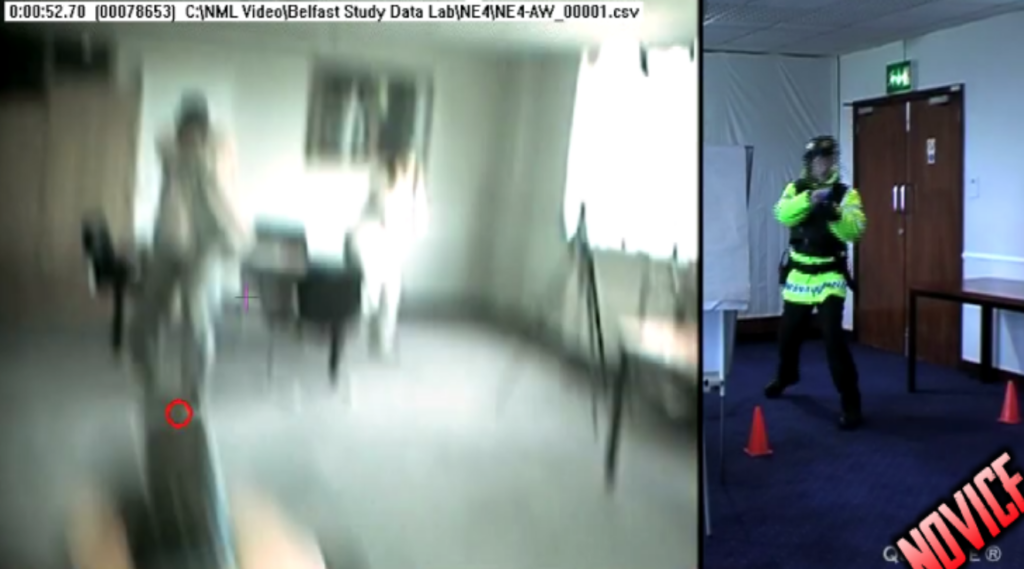
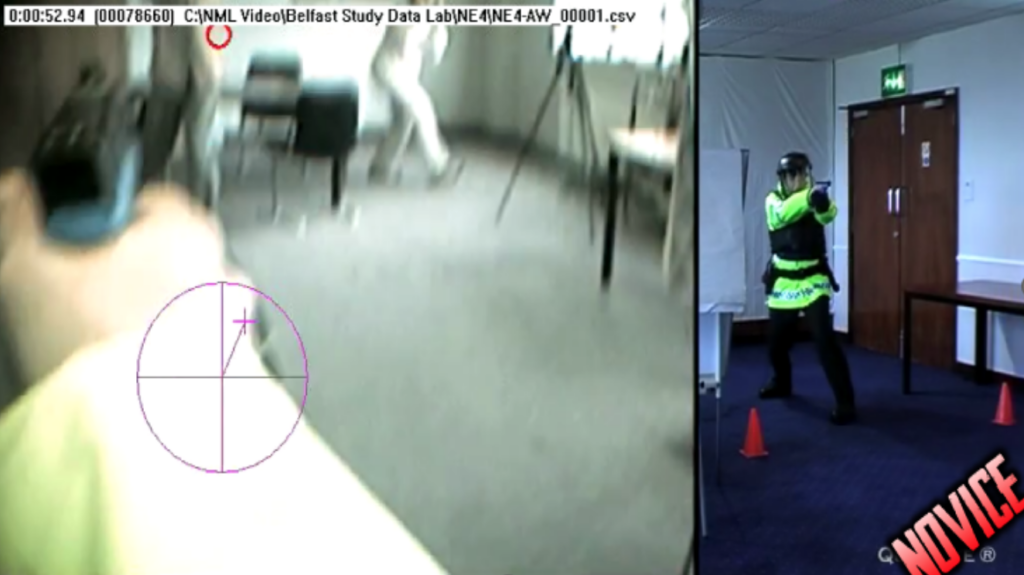
This reinforces to us that it is far more important to understand what is happening, to have Game IQ and to have trained Gaze-Action Coupling.
We believe Game IQ does not come only from having years of Elite Counter Terrorism training and can be taught “On Purpose by Design” in less time.
How could a RDS on a pistol be a benefit in these altercations?
The research just presented indicates they are not. Gaze-Action Coupling is the method of fire that will serve officers best in these close-up, rapidly evolving, ambiguous situations.
Gaze-Action Coupling
The main point for Firearm Instructors to understand is that Gaze-Action Coupling is much more than ‘threat focused fire’.
Threat focused fire can be performed by many to a high degree of accuracy. The scientific community has a term for linking your visual system with your physical system, Gaze-Action Coupling. We have effectively been training Gaze-Action Coupling since we were children, just not specifically with a pistol and not under the stress of a sudden deadly force encounter. This is an important point because under a sudden threat our attention and typically vision is ‘hijacked’ and we fixate on the threat or weapon.
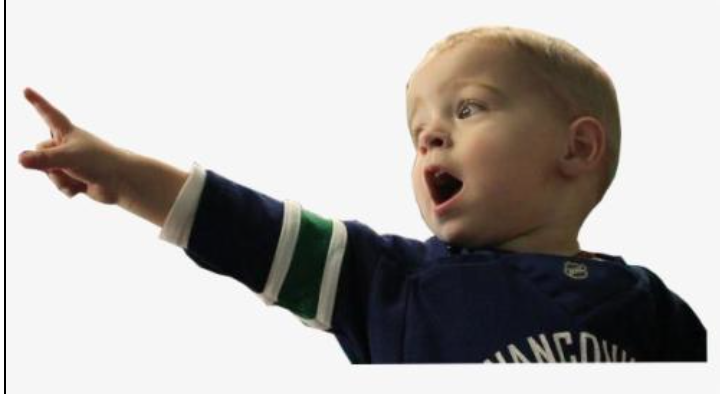
Note the child’s eyes are fixed and most likely their mental attention is also fully committed. We have practiced pointing to what is of interest or captivating us since we were children.
Gaze-Action Coupling
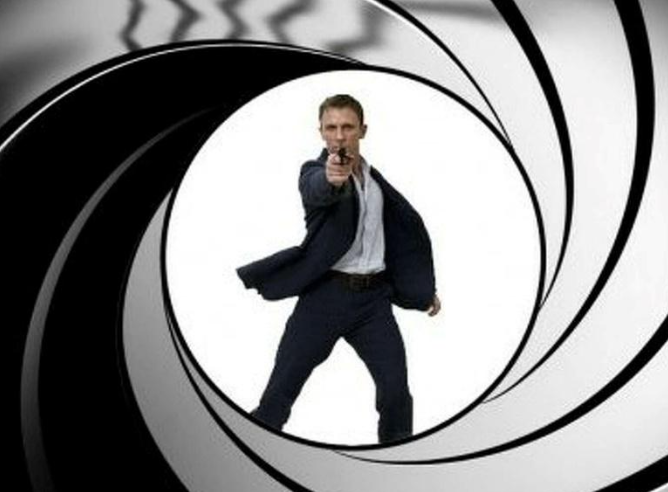
We can train to be more accurate Gaze-Action couplers with a pistol in our hand.
The key here is to practice shifting our eyes & attention to where we want the bullets to hit.
This is not done by any Firearms Instructors we know, “On Purpose By Design”.
Doing this must be trained and that training is primarily done,
NOT with live fire.
How many of you reading this have acted in officer scenarios as a “bad guy” role player? How many of you have been shot by officers in the hand you were holding the weapon in? Especially in rapidly unfolding scenarios or drills?
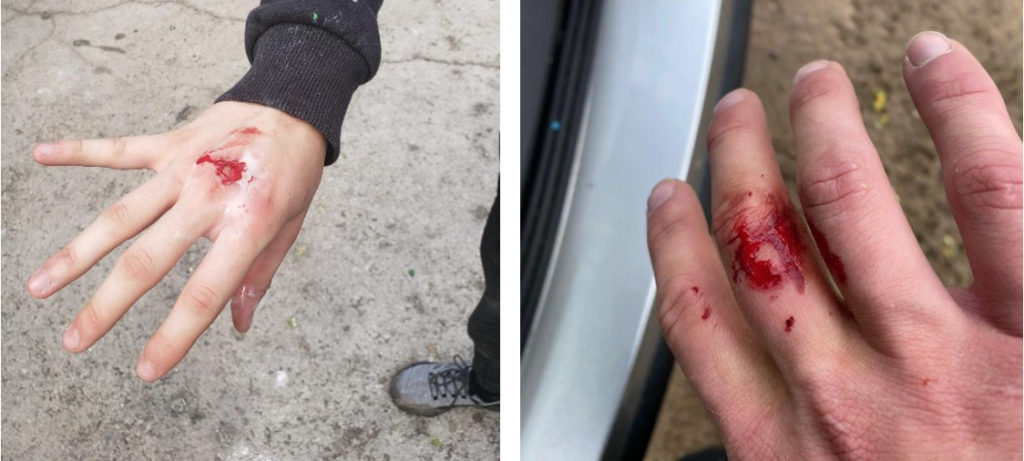
This is pretty accurate shooting and also Gaze-Action Coupling. The impact on the role Player’s hands and not their torso is “our fault”, as the trainers. The officers were not taught to shift their visual gaze from weapon/threat identification to where they want the bullets to go. They remained fixated on the weapon and fired because they were not put into drills to train them to re-focus their mental attention and vision. This is something that can, and we believe must be trained. We have specific interventions for this which are very short and simple.
Gaze-Action Coupling Final Point
Remember the LEOKA stats from 2009 to 2019 show 64% of officers killed by a firearm were shot in the head and neck. 86% were shot in the head, neck and upper chest (see following slide from the Methods of Instruction course, shown with Chris Butler’s permission)
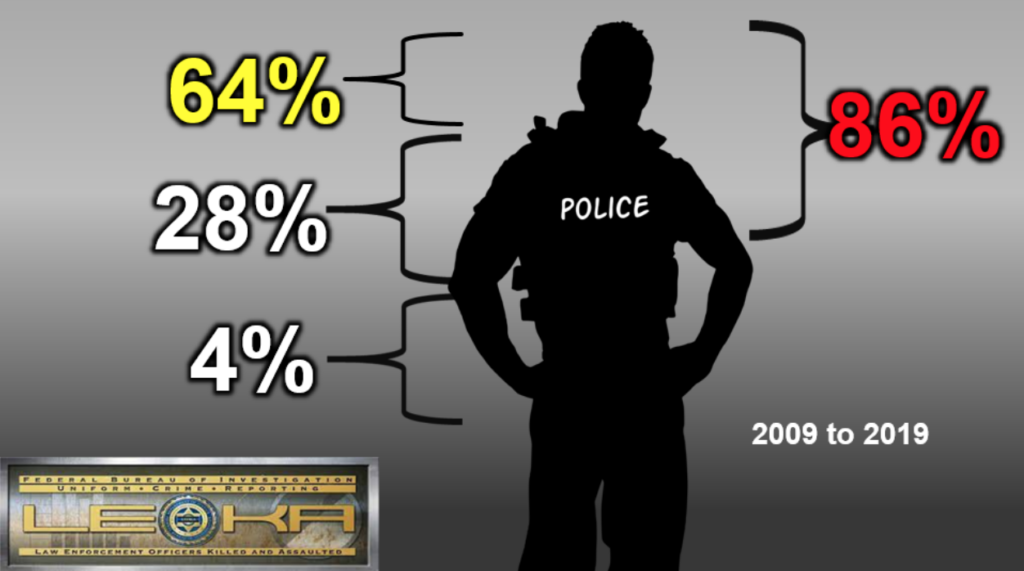
Why are officers shot here?
Are the offenders using their sights in these rapidly unfolding, close range encounters? The answer as you know is the bad Guy is also using Gaze-Action Coupling. The Bad guy is visually and mentally fixated on the officer and looking at them in the face as humans typically do.
When they drive their weapon suddenly to the officer, they ‘naturally’ align it to hit them in the head and neck. This means officers need to be trained in context to immediately move and is the topic of other articles.
Please contact us for further information on Gaze-Action Coupling and the ‘Quiet Eye’. We have several articles on them and have walked many instructors through the principles and how to immediately train them with no extra equipment.
Back to Training With Red Dot Sights
Does that mean pistol RDSs are not a benefit?
RDSs are absolutely a benefit, as long as the technology itself holds up without failure. There are at least two reasons for considering RDSs. The first reason takes place immediately after the officer delivers rounds with Gaze-Action Coupling on a surprise threat at close range.
The sequence would be, as the officer identifies a possible assault, simultaneously gets their pistol out, while moving to a position of advantage and also shifting their vision to where the threat is likely to evolve to properly ID. After the officer initially fires in defense of their own life, as soon as they can ‘get onto’ their sights to take more precise shots, if necessary, an RDS would be of great benefit.
That circumstance is one definite advantage of a RDS. It will be faster to stay visually focused on the threat and to superimpose the red dot over them. With practice that shift will take less time than shifting visual focus between the sights and threat.
For all the reasons initially stated in this article about the pros to an RDS, this then applies. Taking visual focus off the threat means the officer has no chance to perceive if the attacker is still a threat or not, dropped their weapon or not, etcetera.
The second situation an RDS has an advantage is any other scenario that is evolving at a pace slow enough for the officer to ‘get ahead’ enough so they can orient their firearm toward the perceived threat and either deliver rounds or stay visually focused on them to identify when/if they do need to fire.
Our main point here is that whether you have RDS or iron sights you must also practice,
Rapid draw and fire to center mass using Gaze-Action Coupling.
Key Takeaway
Perhaps more importantly we urge any agency who is moving to RDSs to use that extra training time to put officers into drills with Role Players so they can learn pattern recognition and Game IQ. Teaching officers what to look for and where to look for it is far more advantageous as it allows them to accurately anticipate and move sooner.
This is done with Non-Lethal Training Ammunitions, SIRT and other technologies. We believe it far outweighs extended periods of live fire on targets that are not giving officers repetitions of decision-making.
Training Implications
- We urge you to practice very rapid acquisition and presentation of your pistol to an evolving threat. You must move your eyes from threat ID to center mass of where you want to hit while concurrently driving your pistol to that same location. This is Gaze-Action Coupling, and the efficacy can be increased if you also lock your vision onto a small part of the thing you are going to shoot at (called a visual fixation). This is technique was named the ‘Quiet Eye’ by Dr. Vickers when she discovered the phenomena with experts in almost every sport including Olympic Skeet, Trap and Bulls Eye shooting.
We typically see officers who are new to RDSs shooting slowly, even at close distances because they can be more precise with the reportedly easier to see red dot. This will get them killed.
- We strongly suggest using the extra training time we get when moving officers to RDSs for far less live fire and far more pattern recognition. Have them see and react as described in point one, to a person evolving as a possible threat. Have the officer increase their Game IQ.
Doing these drills or practice must incorporate actual decision making through threat identification. This gets us into a topic for another article on a training method that keeps the officer linked to the environment.
Summary
- Law Enforcement seems driven by technology and not Human Factors and Research. LEOKA stats tell us the largest threat to officers are rapidly produced handguns at very close range.
- Studies on officer reaction times show there is not enough time for officers to wait until an attack is happening to respond effectively.
- Studies on object ID show it takes far more time to accurately identify an object then an officer has during a spontaneous attack.
- RDSs can save the time used in a critical incident by keeping an officer visually focused on the scene and threat, not shifting to their sights.
- Optimally performing officers in close-up, rapidly evolving, ambiguous scenarios are not using their sights to fire quickly and accurately.
- Elite officers are moving sooner than Rookies which is by far the most relevant advantage of all. They have Game IQ and this puts them far ahead of the reaction curve, allows for better decision-making (shoot or not) and if they fire, allows for far better accuracy (without using sights or RDS).
- Officers in scenarios and Bad Guys on the street shoot with good accuracy toward what they are looking at and mentally attending to (unpolished Gaze-Action Coupling). We must address this by teaching officers to shift their vision and attention to center mass of what they want to shoot. Also, officers must be trained in context to move their head/neck/upper chest when a sudden threat evolves.
Conclusion
RDSs can be beneficial. It is all in how you go about training your officers how to integrate RDSs into a total scenario, not just shooting drills. Gaze-Action Coupling and Game IQ must be taught no matter what sights (iron or RDS) you are using.
We realize a brief article cannot explain our entire rationale behind why nor the specifics on how to implement effective RDS training. Please contact us with any questions, comments or to discuss how we approach this training.
There is further research done in 2023 by Dr. Michael Kantor that adds to this. We would like to expand on it in future articles and will be presenting it at the 2024 IALEFI (www.ialefi.com), ILEETA (www.ileeta.org) & Force Science conferences. Please contact us privately or at these conferences for more on these concepts.
Citations
Force Science Methods of Instruction (USA) – https://www.forcescience.com/training/methods-of-instruction
Raptor Protection & Safety Services (outside of the USA) – https://raptorprotection.com/methods-of-instruction
Law Enforcement Officers Killed and Assaulted (LEOKA) – https://leoka.org
K. Grill-Spector, N. Kanwisher (2005). “Visual Recognition: As Soon as You Know It Is There You Know What It Is”; Psychological Science; Vol. 16 No. 2;
Lewinski, W. J., Dysterheft, J. L., Bushey, J. M., & Dicks, N. D. (2015). Ambushes Leading Cause of Officer Fatalities – When Every Second Counts: Analysis of Officer Movement from Trained Ready Tactical Positions. Law Enforcement Executive Forum, 15(1). https://doi.org/10.19151/leef.2015.1051a
Vickers, Joan N., and William Lewinski (2012). “Performing under pressure: Gaze Control, decision making and shooting performance of elite and rookie police officers.” Human Movement Science, vol. 31, no. 1, pp. 101–117, https://doi.org/10.1016/j.humov.2011.04.004
Bio
Jeff Johnsgaard is a police officer in his 21st year and currently a Detective Sergeant. He is a trainer for his agency and their academy. Jeff teaches the Methods of Instruction course and other courses for Chris Butler and for Force Science®. Jeff also instructs the Reality Based Training Instructor course with Kenneth Murray. Jeff is a Nationally Certified Instructor under IADLEST, Certified Force Science® Advanced Specialist and Director of Research for the Reality Based Training Association.
Jeff has published over a dozen articles in Law Enforcement publications, has presented at IALEFI, ILEETA, Force Science and PORAC. Jeff’s resume, publications and multiple interviews are all available at www.NaturalTactical.com email jeff@naturaltactical.com

